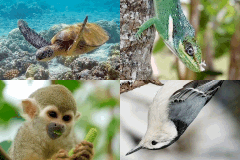AnAge entry for Spalax ehrenbergi
Classification (HAGRID: 02830)
- Taxonomy
-
Kingdom: Animalia
Phylum: Chordata
Class: Mammalia (Taxon entry)
Order: Rodentia
Family: Spalacidae
Genus: Spalax
- Species
- Spalax ehrenbergi
- Common name
- Palestine mole rat
- Synonyms
- Nannospalax ehrenbergi, Spalax aegyptiacus, Spalax berytensis, Spalax intermedius, Spalax kirgisorum
Lifespan, ageing, and relevant traits
- Maximum longevity
- 20.2 years (captivity)
- Source
- Aaron Avivi, pers. comm.
- Sample size
- Small
- Data quality
- Acceptable
- Observations
These animals live on average about 3 years in the wild but can live more than 20 years in captivity. They become sexually mature in their second year of life, though they are difficult to breed in captivity [0675]. Captive animals only show signs of ageing after they are 10 years or older (Eviatar Nevo, pers. comm.). One female of the golani subspecies caught in the wild when about one year-old lived 19.2 years in captivity, making it at least 20.2 years-old when it died accidently. Another wild-caught specimen of the galili subspecies was 17 years-old when it died in captivity (Aaron Avivi, pers. comm.).
There is some controversy concerning the taxonomy of this species. Some authors consider it a superspecies with various species. Besides, some authors place this species in the Spalacidae family.
Life history traits (averages)
- No information is available on life history. Please contact us if you wish to suggest or contribute data.
Metabolism
- Typical body temperature
- 309ºK or 35.6ºC or 96.0ºF
- Basal metabolic rate
- 0.5850 W
- Body mass
- 133.8 g
- Metabolic rate per body mass
- 0.004372 W/g
References
- [1308] Myhrvold et al. (2015), An amniote life-history database to perform comparative analyses with birds, mammals, and reptiles
- [1128] Manov et al. (2013), Pronounced cancer resistance in a subterranean rodent, the blind mole-rat, Spalax: in vivo and in vitro evidence (PubMed)
- [0960] Schulke et al. (2012), Living with stress: regulation of antioxidant defense genes in the subterranean, hypoxia-tolerant mole rat, Spalax (PubMed)
- [0966] Edrey et al. (2012), Sustained high levels of neuregulin-1 in the longest-lived rodents; a key determinant of rodent longevity (PubMed)
- [0961] Avivi et al. (2007), P53 in blind subterranean mole rats--loss-of-function versus gain-of-function activities on newly cloned Spalax target genes (PubMed)
- [0711] Caballero et al. (2006), Antioxidant activity in Spalax ehrenbergi: a possible adaptation to underground stress (PubMed)
- [0962] Avivi et al. (2005), Increased blood vessel density provides the mole rat physiological tolerance to its hypoxic subterranean habitat (PubMed)
- [0036] Savage et al. (2004), The predominance of quarter-power scaling in biology
- [0420] White and Seymour (2003), Mammalian basal metabolic rate is proportional to body mass2/3 (PubMed)
- [0604] Zuri and Terkel (2001), Reversed palatal perforation by upper incisors in ageing blind mole-rats (Spalax ehrenbergi) (PubMed)
- [0434] Ronald Nowak (1999), Walker's Mammals of the World
- [0675] Eviatar Nevo (1999), Mosaic Evolution of Subterranean Mammals: Regression, Progression, and Global Convergence
External Resources
- Integrated Taxonomic Information System
- ITIS 970560
- Animal Diversity Web
- ADW account
- Encyclopaedia of Life
- Search EOL
- NCBI Taxonomy
- Taxonomy ID 30637
- Entrez
- Search all databases
- Ageing Literature
- Search Google Scholar or Search PubMed
- Images
- Google Image search
- Internet
- Search Google

